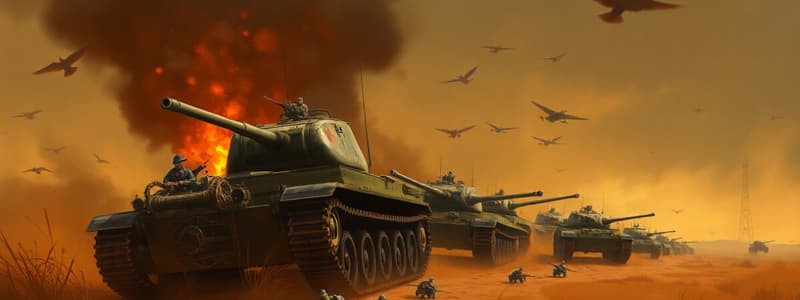Podcast
Questions and Answers
Which event marked the beginning of World War II in Europe?
Which event marked the beginning of World War II in Europe?
- The German invasion of Poland (correct)
- The signing of the Nazi-Soviet Non-Aggression Pact
- The Battle of Britain
- The attack on Pearl Harbor
In what year did Japan initiate its expansion in China?
In what year did Japan initiate its expansion in China?
- 1940
- 1931
- 1937 (correct)
- 1941
What event led to the United States joining World War II in the Asia-Pacific theater?
What event led to the United States joining World War II in the Asia-Pacific theater?
- The invasion of China
- The Battle of Britain
- The attack on Pearl Harbor (correct)
- The invasion of Poland
Which of the following is a characteristic of 'total war', as exemplified by World War II?
Which of the following is a characteristic of 'total war', as exemplified by World War II?
What was the primary strategy employed by Germany to quickly overwhelm its enemies?
What was the primary strategy employed by Germany to quickly overwhelm its enemies?
Which of the following was a vulnerability of Germany's Blitzkrieg strategy?
Which of the following was a vulnerability of Germany's Blitzkrieg strategy?
What critical event occurred in May 1940 during the German invasion of France?
What critical event occurred in May 1940 during the German invasion of France?
Why was the Allied retreat to Dunkirk strategically significant?
Why was the Allied retreat to Dunkirk strategically significant?
What was the 'Blitz'?
What was the 'Blitz'?
What was the primary objective of the German Luftwaffe during the Battle of Britain?
What was the primary objective of the German Luftwaffe during the Battle of Britain?
What was the Nazi-Soviet Non-Aggression Pact, and when was it signed?
What was the Nazi-Soviet Non-Aggression Pact, and when was it signed?
What was a key factor that led to the failure of Operation Barbarossa?
What was a key factor that led to the failure of Operation Barbarossa?
In what way did the USA support the Allies before officially entering World War II?
In what way did the USA support the Allies before officially entering World War II?
What was the main objective of Operation Overlord (D-Day)?
What was the main objective of Operation Overlord (D-Day)?
What event marked the formal surrender of Germany, signifying Victory in Europe (V-E Day)?
What event marked the formal surrender of Germany, signifying Victory in Europe (V-E Day)?
Which of these events took place in 1942?
Which of these events took place in 1942?
What was the key strategic objective for Japan in attacking Pearl Harbor?
What was the key strategic objective for Japan in attacking Pearl Harbor?
What was the main consequence of the Japanese attack on Pearl Harbor for the United States?
What was the main consequence of the Japanese attack on Pearl Harbor for the United States?
What critical advantage did the USA retain after the attack on Pearl Harbor?
What critical advantage did the USA retain after the attack on Pearl Harbor?
What prompted the initiation of the 'island hopping' strategy in the Pacific Theater?
What prompted the initiation of the 'island hopping' strategy in the Pacific Theater?
Which of these describes the 'island hopping' strategy?
Which of these describes the 'island hopping' strategy?
What was a primary reason for the United States' decision to use atomic bombs on Japan?
What was a primary reason for the United States' decision to use atomic bombs on Japan?
What was the state of Japan's resources by 1945 that contributed to their eventual surrender?
What was the state of Japan's resources by 1945 that contributed to their eventual surrender?
How did the defeat at the Battle of Midway impact Japan's naval capabilities?
How did the defeat at the Battle of Midway impact Japan's naval capabilities?
Which of the following statements best describes the condition of France immediately after its surrender in June 1940?
Which of the following statements best describes the condition of France immediately after its surrender in June 1940?
How did the signing of the Nazi-Soviet Non-Aggression Pact in August 1939 influence the start of World War II?
How did the signing of the Nazi-Soviet Non-Aggression Pact in August 1939 influence the start of World War II?
What was the long-term strategic significance of the Battle of Britain, despite the extensive damage and loss of life?
What was the long-term strategic significance of the Battle of Britain, despite the extensive damage and loss of life?
What strategic miscalculation by Germany significantly contributed to the failure of Operation Barbarossa?
What strategic miscalculation by Germany significantly contributed to the failure of Operation Barbarossa?
In considering the Allied strategy to liberate France, what made Normandy the chosen landing site for the D-Day invasion, despite its formidable defenses?
In considering the Allied strategy to liberate France, what made Normandy the chosen landing site for the D-Day invasion, despite its formidable defenses?
Despite the extensive devastation caused by the atomic bombs, why did some members of the Japanese military resist the Emperor's decision to surrender?
Despite the extensive devastation caused by the atomic bombs, why did some members of the Japanese military resist the Emperor's decision to surrender?
What critical logistical challenge did the United States Navy face during the island hopping campaign in the Pacific, and how did they overcome it?
What critical logistical challenge did the United States Navy face during the island hopping campaign in the Pacific, and how did they overcome it?
Which of the following represents the most accurate assessment of the strategic consequences of the Battle of Midway?
Which of the following represents the most accurate assessment of the strategic consequences of the Battle of Midway?
During the Battle of Britain, what previously underestimated technology proved vital to the British Royal Air Force’s (RAF) defense, allowing them to effectively counter the German Luftwaffe's superior numbers?
During the Battle of Britain, what previously underestimated technology proved vital to the British Royal Air Force’s (RAF) defense, allowing them to effectively counter the German Luftwaffe's superior numbers?
How did Stalin's scorched earth policy complicate Operation Barbarossa?
How did Stalin's scorched earth policy complicate Operation Barbarossa?
Flashcards
Blitzkrieg
Blitzkrieg
A military strategy utilizing speed and surprise to overwhelm opponents.
Luftwaffe
Luftwaffe
Germany's air force that carried out large attacks on Britain.
The Blitz
The Blitz
A campaign by the German Airforce, bombing British cities.
Operation Barbarossa
Operation Barbarossa
Signup and view all the flashcards
Operation Overlord
Operation Overlord
Signup and view all the flashcards
Battle of Midway
Battle of Midway
Signup and view all the flashcards
Island Hopping
Island Hopping
Signup and view all the flashcards
Kamikaze
Kamikaze
Signup and view all the flashcards
German invasion of Poland
German invasion of Poland
Signup and view all the flashcards
Japan's expansion in China
Japan's expansion in China
Signup and view all the flashcards
Total War
Total War
Signup and view all the flashcards
Blitzkrieg
Blitzkrieg
Signup and view all the flashcards
Dunkirk
Dunkirk
Signup and view all the flashcards
Operation Barbarossa
Operation Barbarossa
Signup and view all the flashcards
D-Day's Success
D-Day's Success
Signup and view all the flashcards
Pearl Harbor
Pearl Harbor
Signup and view all the flashcards
Battle of Midway
Battle of Midway
Signup and view all the flashcards
Isolation and conquest
Isolation and conquest
Signup and view all the flashcards
Atomic Bombs
Atomic Bombs
Signup and view all the flashcards
Study Notes
- Chapter 9 covers the conclusion of WWII in both Europe and the Asia-Pacific region.
Introduction
- WWII started in Europe with Germany's invasion of Poland.
- Japan began expanding in China in 1937.
- The US joined the Asia-Pacific war in 1941, escalating it into a total war. Total war involves unrestricted weapon use, mobilization of all resources including civilian targets.
Reasons for Allied Victory in WWII
- Allied strengths:
- The importance of the United States
- The importance of Britain
- The importance of the USSR
- Axis weaknesses:
- Germany's military weaknesses
- Japan's military weaknesses
Key Developments in Europe (1939-1945)
- Germany employed Blitzkrieg ("lightning war") tactics, starting in 1939.
- France fell to Germany in 1940.
- The Battle of Britain occurred in 1940.
- Operation Barbarossa, the German invasion of the Soviet Union, was launched in 1941.
- Operation Overlord (D-Day) took place in 1944.
- Victory in Europe came in 1945.
Blitzkrieg Strategy
- Utilized a swift and focused attack.
- Overwhelmed enemies using mobile forces.
- A result of Germany lacking resources like copper, rubber, and oil to support long-term campaigns.
- Ineffective when strong foes such as the USSR and USA entered the war.
Fall of France (1940)
- Germany attacked France in May 1940.
- Despite support from Britain, France fell to Germany.
- Allied forces retreated to Dunkirk.
- The Allied armies were highly vulnerable but some escaped.
- German generals slowed down the advance.
- The soldiers at Dunkirk were rescued.
- France surrendered in June 1940.
- It was believed if Germany didn't cease the advance at Dunkirk, both Britain and France were forced to surrender.
Battle of Britain
- The German Airforce launched attacks to achieve air superiority.
- Germany attacked British cities in a campaign called the Blitz.
- Britain continued the war effort and resisted surrender, despite losses and damages.
Operation Barbarossa (1941)
- Hitler and Stalin previously signed the Nazi-Soviet Non-Aggression Pact.
- In June 1941, Germany launched Operation Barbarossa.
- Initial Soviet failures put Stalin on the verge of abandoning Moscow.
- The Germans were not able to overwhelm the USSR fast enough.
- Resources provided by the USA through the Lend-Lease scheme allowed Stalin to reorganize war efforts.
Operation Overlord: D-Day (1944)
- The USA declared war against Germany in 1941, assuring assistance for the Allies.
- In September 1943, Italy signed an armistice with the Allies.
- Germany was thus put in a vulnerable position and was fighting alone. D-Day was successful due to overwhelming resources, effective planning, and leadership, with:
- 13,000 Allied aircraft against 400 German aircraft.
- 130,000 Allied troops crossing the English Channel by sea.
- German forces in Normandy were cut off from reinforcements.
Victory in Europe
- The Germans launched counterattacks and used new equipment, such as guided missiles and jets, to no avail.
- The Soviets achieved a major victory in Stalingrad in 1943.
- Soviet troops encircled Berlin by January 1945.
- US and British forces met Soviet forces at the River Elbe in Germany.
- Germany formally surrendered on May 8, 1945.
Key Developments in Asia Pacific (1937-1945)
- Attack on Pearl Harbor (1941)
- Battle of Midway (1942)
- Island Hopping Strategies (1942-1945)
- Atomic Bomb (1945)
Asia-Pacific Context
- Japan expanded into China, occupying Shanghai, Wuhan, and Nanjing in 1937.
- Japan exploited occupied resources to support the war.
- From 1941, Japan attacked various parts of the Pacific region.
- By 1942, Japan occupied many territories in Asia-Pacific.
- The Allies prioritized defeating Germany but continued resisting Japan.
- By May 1942, Japanese operations were gradually pushed out of many territories.
- Japan faced the Allies alone after Germany surrendered in 1945.
Attack on Pearl Harbor (1941)
- The United States lost 18 ships, including 5 battleships.
- Over 2,000 Americans died.
- HMS Prince of Wales and HMS Repulse were sunk three days later.
- US intelligence failures led to a surprise Japanese attack.
- The USA entered the war as a result.
- Americans united and dedicated resources to the war.
- Anger amongst the public enabled Roosevelt to rally the country.
- Japanese failed to destroy US aircraft carriers.
- USA retained tactical advantage.
- Japanese failed to gain control of the pacific.
Battle of Midway (1942)
- Japan intended to control Midway Islands to use as a naval air base.
- Midway was located on the route to Pearl Harbor. American forces decoded Japanese messages:
- They prepared for the attack.
- Japan lost 4 aircraft carriers and ¾ of its experienced pilots.
- This weakened naval and air defense capabilities.
- Japan could not match US shipyards and aircraft factories output.
Island Hopping Strategy (1942-1945)
- Japan had already built a large empire in Asia and the Pacific.
- The Allies tried to regain control by utilizing island hopping.
- Strategy:
- Air attacks and submarines isolated Japanese-held areas.
- Poorly defended islands were conquered.
- The U.S. would then further cut off ships.
- The ships would cut off essential supplies to well-defended islands.
- The allies had fewer casualties and gained striking distance of Japan.
- Japan lacked the resources to defend their empire.
Dropping of the Atomic Bomb (1945)
- Japan overstretched resources.
- Japan was unable to defend the empire.
- The US conducted air raids on Japanese soil, such as the Tokyo bombing.
- In April 1945, the Allies took Okinawa.
- Allies killed/captured 100,000 soldiers defending Okinawa, refusing to surrender.
- Allied ships were badly damaged by Kamikaze suicide bombers.
- Japan was pushed back at great cost to the Allies
- The USA was confident of victory over Japan
- The new President Truman was faced with the prospect of heavy casualties if the battle continued.
- The US soldiers needed to beat back the Japanese island by island.
- Then the army would invade Japan itself.
- Alternative: Drop the atomic bomb
- Quick with the Americans wanting quick and unconditional surrender,
- atomic bombs were dropped on Hiroshima & Nagasaki in quick succession.
- The atomic bombs lead the Japanese to believe The USA had a stockpile of weapons.
- The Japanese Emperor told the army to surrender.
- Some of the military leaders disagreed with the Emperor.
- Instead they attempted the throw the emperor and continue the war.
- Japan surrendered after the Nagasakibomb on 14th August 1945.
Studying That Suits You
Use AI to generate personalized quizzes and flashcards to suit your learning preferences.



